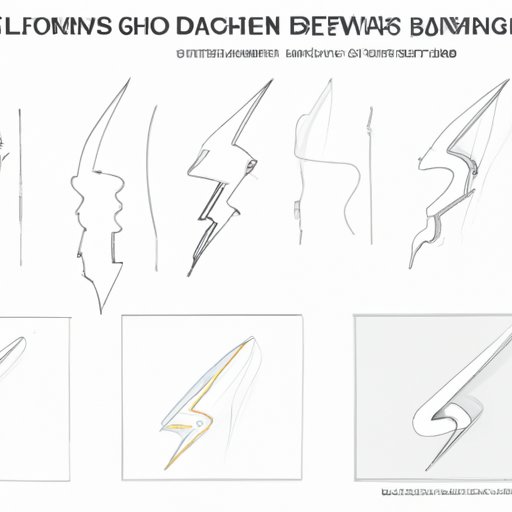
Introduction
Many artists struggle to capture the essence of lightning in their drawings, as it is a complex and dynamic subject. However, with the right guidance and practice, anyone can learn to draw stunning and realistic lightning bolts. In this tutorial, we will share step-by-step instructions on how to draw lightning, as well as additional approaches to enable you to experiment with styles and techniques.
Step-by-Step Tutorial Approach
The first approach is a step-by-step tutorial that provides detailed instructions for each stage of creating the lightning bolt.
Step 1: Creating the Shape of the Lightning Bolt
The first step is to draw the outline of the lightning bolt. Start by creating a rough shape, keeping in mind the direction and perspective of the bolt. Use a light pencil to make a faint sketch, so you can make corrections later on.
Step 2: Adding Variation to the Shape of the Bolt
Lightning is a dynamic and unpredictable force of nature, so you’ll want to add some variation to the outline of the bolt. Use some reference images to add jagged edges and zigs, and ensure that the lines vary in width to convey a sense of depth and movement.
Step 3: Drawing the Lightning Glow
The next step is to add glow to the lightning bolt. Use shades of yellow and white to create the glowing effect around the edges of the bolt, keeping in mind the direction of the light source. Remember to keep the glow subtle, so it doesn’t overpower the rest of the drawing.
Step 4: Adding Final Touches to the Drawing
Once you’ve finished adding the basic elements of the lightning bolt, it’s time to make final touches and adjustments. Erase any pencil lines that are still visible, adjust the lines to create a sense of movement and dynamism, and add any final details to bring the drawing to life.
Historical Context Approach
The second approach is to look at the historical context of lightning, exploring its symbolism in various cultures and artistic movements. This approach will provide you with a deeper understanding of the cultural and artistic significance of lightning, enabling you to incorporate it more accurately and meaningfully in your work.
Symbolism and Tips for Artists
Throughout history, lightning has had various symbolic meanings in different cultures, ranging from a divine sign to a destructive force. To create an accurate representation of lightning in your artwork, it’s important to research the cultural and historical context surrounding it. Additionally, by studying the techniques and styles used by different artists throughout history, you’ll be able to incorporate elements of their work into your own.
Examples of Lightning in Art
If you’re looking for inspiration, you can explore how lightning has been represented in various artworks throughout history. From ancient cave paintings to contemporary digital art, lightning has been an enduring source of fascination for artists.
Materials-Focused Approach
The third approach is to focus on the materials used to create lightning. This approach necessitates a basic understanding of materials and how they may be used to accomplish specific effects.
This technique includes the following:
1. Pencil
Pencils are versatile and can be used to create various effects when drawing lightning. Doing sketches with a light touch is an excellent way to begin, followed by adding and shading details with darker tones gently.
2. Marker
Markers may provide bolder lines and more vibrant colors than pencils, allowing for a more straightforward and detailed approach to lightning. Remember to use a marker with varied thicknesses and test it out on scrap paper first to get the right effect.
3. Digital Drawing Tools
Digital drawing tools can be used to create lightning drawings with more complex features and to experiment with various effects such as glowing lights and motion blur.
Experimental Approach
The fourth approach is to experiment with various ideas, techniques, and designs while drawing lightning, allowing for a more creative approach. This technique encourages artists to explore the inherent qualities of their materials and how to create unique effects with them, such as unusual colors or texture.
Examples of Creative Approaches for Drawing Lightning
There are several ways to use this technique to create unique and fresh drawings of lightning, include using different colors, combining various art materials, and experimenting with different stroke widths to offer a sense of dynamism and texture to the drawing.
Inspirational Approach
The final approach is to find inspiration in the work of other artists who have created stunning lightning-themed artwork. This approach can provide you with ideas and encouragement to push the limits of your creativity when working with lightning.
Showcase Examples of Stunning Lightning-Focused Artwork
Finally, you may use social media or online galleries to find examples of lightning-themed artwork created by other artists. Find images of lighting artwork that resonate with you and study them carefully, dissecting their components and trying them out in your own work.
Conclusion
In conclusion, lightning can be a challenging subject to draw, but with the right mindset, techniques, and references, anyone can create stunning drawings of this natural phenomenon. We’ve provided you with a range of approaches to try, from step-by-step tutorials to historical context, inspiring approaches, and more. So don’t hesitate to experiment with different techniques, materials, and designs in your next lightning drawing project.
Image Sources:
‘Lightning bolt sketch, vector hand drawn illustra…’ by Artist Online – stock.adobe.com
‘HSEQ lightning’ by Lars Falkdalen Lindahl – stock.adobe.





